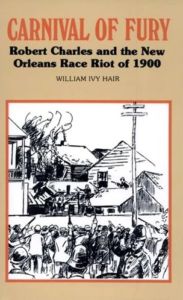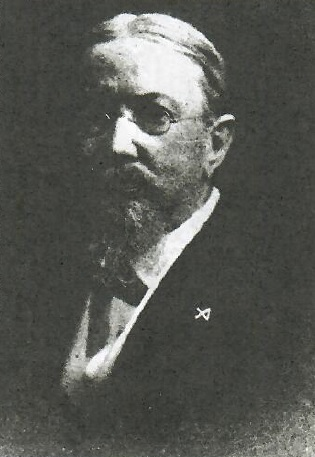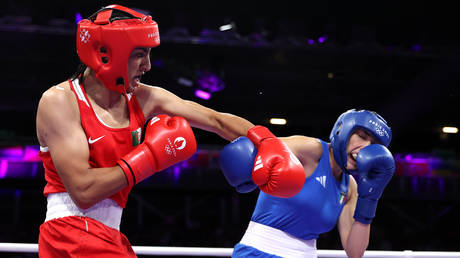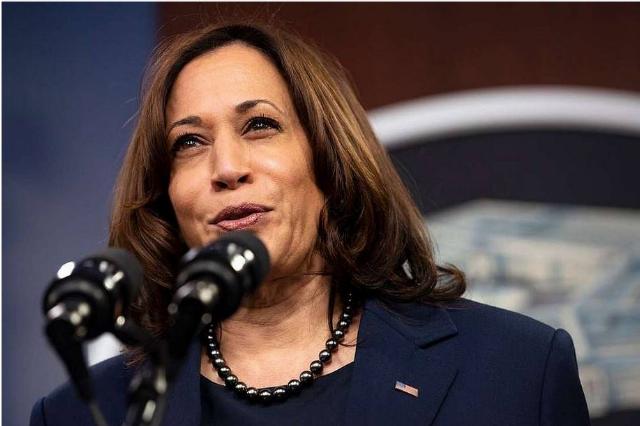Carnival of Fury
Virtually all whites in the South, including New Orleanians, were absolutely convinced that the mass of Negroes were innately inferior mentally and morally to most whites, and were perhaps even more certain that wherever two disparate races occupied the same soil one race must rule the other.
—William Ivy Hair, Carnival of Fury
Imagine that it is one century from now. It is a more civilized age and a time of great reflection among the black diasporas of the world. Of the utmost importance to the zeitgeist is black guilt over the enormous crime and violence that they as a people had inflicted upon their undeserving white host nations for over 250 years. In this future, an empathetic black historian decides to take a second look at a certain white man of history who had been greatly — and perhaps unfairly — maligned during his lifetime: Dylann Roof.
You see, this Mr. Roof may have been a mass murder, but he was also a highly intelligent and, um, perspicacious young man who had some, er, interesting perspectives on the, ah, complicated topic of race during a period in history which we must all agree was (ahem!) morally murky. His fascinating and tragic (cough!) life history has, up until now, been criminally neglected by conscientious scholars.
Absurd, isn’t it? Well, this scenario is only slightly more absurd than Carnival of Fury, William Ivy Hair’s celebrated 1976 history of the Negro mass murderer Robert Charles and the deadly race riot in New Orleans in 1900. In the opening of his work Hair quotes from the New Orleans Times-Democrat, which nicely captures the outrage whites felt over this hidebound criminal who, in late July of that year, had murdered seven whites, four of whom were policemen, and injured 20 more with his Winchester rifle:
It is only natural that the deepest interest should attach to the personality of Robert Charles. What manner of man was this fiend incarnate? What conditions developed him? Who were his preceptors? From what ancestral strain, if any, did he derive his ferocious hatred of the whites, his cunning, his brute courage, the apostolic zeal with which he displayed in spreading the propaganda of African equality? These are questions involving one of the most remarkable psychological problems of modern times.
Because information about Charles is so sketchy, Hair resorts numerous times to rumor, witnesses’ memories, and often-conflicting news reports to paint a suitable picture. He admits there was a lot of guesswork. In order to beef his book up to 200 pages, he also offers a serviceable, if quite slanted, history of Copiah County, Mississippi, where Charles was born, and of New Orleans itself from Reconstruction to the time of Charles’ lethal rampage. But Hair’s partisan, pro-black bias becomes clear early on when he attempts to claim the principled middle ground between hero and villain when depicting his subject. Historian W. Fitzhugh Brundage goes even further in the Foreword, framing Charles’ killing spree as “resistance against white violence” and complaining about “white brutality and hypocrisy,” while calling Charles’ mass murder spree “a justifiable act of self-defense.” Brundage conveniently says nothing about black violence and crime, thereby ignoring the legitimate reasons why whites would want to establish supremacy to begin with.
Hair begins with the falsehood that “[r]econstruction in Mississippi was scarcely the saturnalia of carpetbagger and corruption and Negro ineptitude that conservative Democrats would describe in campaign jeremiads for generations to come.” He offers one source for this and studiously ignores the copious data amassed by those such as E. Merton Coulter and Thomas Nelson Page, which point to a drastic uptick in black crime and violence during Reconstruction and beyond. Many of these crimes, it should be noted, involved the rape and abuse of white women. Hair then offers a brief history of late-century white supremacy in Mississippi. He describes the ways in which ordinary blacks such as the Charles family had to deal with political and social repression in the face of the freedom and equality afforded them by the recently-amended US Constitution.
Things came to a head in Copiah County during the local elections of 1883. A white man named John Prentiss “Print” Matthews and his Fusion-Independent ticket threatened to unseat the Democratic majority in Copiah County and the overt white supremacy it enforced. As a former Sheriff and member of the planter class, as well as a Republican and Unionist during the Civil War, Matthews enjoyed great popularity among whites and blacks alike. His coalition posed enough of a threat to the status quo that the Democratic establishment needed to go beyond its usual intimidation tactics and fraud to win the elections. When Matthews attempted to vote, after being warned several times not to, a Democrat operative shot him dead.
Afterwards, black interest in Copiah County’s politics drastically diminished as many simply left rather than deal with the onerous whites. Hair notes that black behavior actually improved after the Matthews murder despite whatever private grievances blacks may or may not have felt. Meanwhile, Matthews’ murderer got off scot-free and enjoyed considerable local acclaim. Copiah County was, as Hair describes it, “a world unto itself.” The provincialism of its white inhabitants was extreme even for Mississippi, and they did not give a hang about national public opinion or what the US Senate subcommittee had to say about the Print Matthews murder. They were protecting their way of life against the encroachment of universal progress, and nothing short of an invading army was going to stop them.
This was the potently anti-black atmosphere in which Robert Charles grew up. There is no record of him or his family being involved in the political violence described above. In fact, there is very little information on Charles at all. We know he was born in 1865 and that he left to work as a laborer in Vicksburg, Mississippi in 1887 (where “[b]lack crime against whites occurred almost nightly,” according to Hair). He was a big man for his day at six feet tall and close to 200 pounds. He was of dark complexion and, for all the police knew, was quiet and kept to himself. He carried a pistol whenever he could. In 1892, he and his brother engaged in a shootout with a white flagman at a train depot near Vicksburg over a stolen pistol; no one was injured, and neither Charles brother was caught.
After this, Charles assumed the alias of Curtis Robertson and returned to Copiah County. Two years later he appeared in court for the unlawful retailing of liquor. He was fined. He skipped town rather than pay up. Two years later he returned to court, pled not guilty, was found not guilty, and then moved more or less permanently to New Orleans.
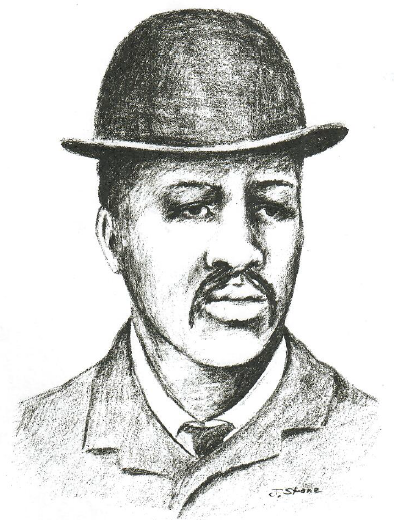
A contemporary sketch of Robert Charles based on historic newspaper drawings and descriptions from people who knew him.
Hair then provides a brief and passive-aggressively anti-white history of New Orleans in which he claims that “the Creoles of color and the blacks had a problem in common, and that was white people.” Essentially, blacks had more to worry about from white supremacy than from each other, which, given their criminal tendencies, is hard to believe. Hair cites police data from 1899 and concludes that “considering the racial proportions of New Orleans’ population, the black arrest rate was not that much higher than that of whites.” He also claims that “[v]iolent street muggings of respectable citizens were quite rare, and the murder of whites by blacks rarer still.” Yet, never does it occur to him that strictly-enforced white supremacy may have been the reason for all this peace and quiet. One need only to look at violent black behavior in the absence of white supremacy — or any other kind of supremacy — to see that this is a legitimate point.
Hair studies the material discrepancies between the races in New Orleans and, without even bothering to address race realism, bemoans the inferior lot of blacks in relation to whites, Creoles in relation to whites, and blacks in relation to Creoles. Whites had indeed established a racial caste system in New Orleans and were vigilant in enforcing it. This was especially the case in the city’s public transit system. On one hand, Hair complains of the way in which the New Orleans blacks received the least education, lived in the flimsiest structures, suffered the most police harassment and abuse, and enjoyed the fewest public services (including sanitation). On the other hand, he writes of how the blacks kept coming to New Orleans for all its opportunities. He writes approvingly of the exciting new music called jazz, and of the edge black laborers enjoyed over whites since they were often able to undercut their wages. He also writes about the many hundreds of black roustabouts who handled the “cotton bales, molasses barrels, and other heavy freight on the river packets that steamed to and from New Orleans.” Like a precursor to the National Football League, traders would employ big, burly black men to do back-breaking physical labor that whites wouldn’t do — and pay them handsomely for it.
One contemporaneous New Orleans personage highlighted in Carnival of Fury needs to be mentioned: Henry J. Hearsey, the influential editor of the New Orleans States. Hearsey, a former Confederate Major, was a committed race realist and white supremacist who, according to Hair, never shut up about it. He once promoted the violent suppression of blacks — even to the point of a genocidal race war — if blacks ever decided to seriously challenge white power. Hair describes Hearsey as “utterly sincere, and, unlike so many prominent figures in Louisiana, was personally honest.”
It seems Hair cannot reconcile Hearsey’s impeccable honor with his heretical racial beliefs. As a result, he writes quite eloquently about him:
Nor did Hearsey ever accept the northern-imposed Thirteenth Amendment. As late as 1900 he was still denouncing the emancipation of slaves as “a crime.” Aging, weakened by Bright’s disease and far too much whiskey, he was fiercely proud that his opinions on race and politics had changed not one whit since the night Fort Sumter was fired upon. The dead Confederacy was his great, lost love; to change himself would be to dishonor her.
Once in New Orleans, Robert Charles became increasingly interested in the back-to-Africa movement, which was gaining momentum among both blacks and whites at the time. He joined the International Migration Society, which was headed by a white man named Daniel J. Flummer and with whom Charles maintained correspondence. Charles also joined the African Methodist Episcopal Church, which was led by the like-mind black Bishop Henry M. Turner. Charles acted as an unpaid sub-agent for both organizations, distributing their pro-emigration literature to the black communities in New Orleans whenever he could. Charles was self-educated and known to be fairly literate. He collected books and magazines, mostly on the topic of race. It was also reported that he deeply resented the anti-black political establishment in Mississippi and Louisiana. When the accused black murderer and rapist Sam Hose was tortured and lynched in Georgia in 1899, Charles reportedly was “beside himself with fury.”
Then, at around 11 PM on July 23, 1900, he and a friend were sitting on the steps of a home owned by a white family, waiting to visit with his girlfriend, who lived nearby. Three patrolmen approached and questioned the Negroes. Something they said must have offended Charles because he stood up, which the police interpreted as a menacing move. Following a brief scuffle, one of the policemen, who was much smaller than Charles, fired his weapon. Charles then returned fire and injured one of the officers. He then fled and easily outran the one pursuing officer despite having been shot in the leg. After this, Charles returned to his apartment to dress his wound. When more police arrived, he murdered two of them in cold blood with his Winchester rifle, collected his ammunition, and fled once again, this time to a hideout spot where he was determined to take out as many white people as possible before his inevitable demise.
It took the New Orleans police nearly a week to find him. Once they did, thousands of enraged whites surrounded Charles’ refuge and pumped it full of bullets. Meanwhile, Charles, who had somehow become an expert marksman, took potshots from windows. He held out for hours and shocked the whites with his deliberate calm and effective shooting under pressure. They eventually smoked him out and killed him with great redundancy, even to the point of allowing the brother of one of the slain officers the honor of feeding the corpse one last dose of lead.
During this weeklong ordeal, New Orleans suffered a disgraceful race riot in which mobs of incensed whites went “coon hunting” in the black part of town, with all the predictable results. Keep in mind that several blacks were aware of Charles’ hiding spot and kept it from the police. Poorer, and especially younger, blacks could also barely suppress their glee at their man’s exploits. This only enflamed the white desire for vengeance. Prior to nabbing Charles, roving bands of whites managed to kill three blacks — as well as two whites by accident — seriously injure six, and beat up some 50 more. A white man stood in the teeth of the mob and dared argue that Robert Charles deserved due process rather than a rope. He nearly got the rope himself, had it not been for intervening police.
After Charles’ body was taken away, rampaging whites killed two more blacks, one while he was in police custody. They also ransacked homes, destroyed property, and burned a Negro school to the ground. As a coda to this orgy of violence, the black informant who had tipped the police off regarding Charles’ whereabouts was reading a book on his stoop about a month later when a neighbor approached him out of the blue and put a bullet in his head. This neighbor was also black, and was a great admirer of Robert Charles.
Much was made of all of this afterwards. About as many whites were arrested as blacks, but nearly all of the charges were eventually dropped. The local newspapers couldn’t contain their superlatives condemning Charles, while the national papers expressed their unabashed horror. Ironically, the one white voice that expressed anything approaching evenhandedness belonged to Major Hearsey:
As an extreme Negrophobe of long standing, Hearsey might have been expected to attribute Robert’s courage to cocaine, or insanity, or anything except manly qualities. Yet the image of anyone — even a black person — battling so resolutely against such hopeless odds irresistibly appealed to the major’s strong romantic and medieval instincts. The day after Robert died, Hearey confessed to his readers that even though Charles was colored, and despite the fact that he had killed and wounded so many white citizens and police, “[I] cannot help feeling for him a sort of admiration prompted by his wild and ferocious courage.”
The more I hear about this Hearsey fellow, the more I like!
For their part, the blacks of New Orleans made Robert Charles into a folk hero and were, according to Hair, “regretful only that he had not taken more policemen with him when he died.” A song praising Charles made the rounds, even reaching the ear of famous jazz musician Jelly Roll Morton. Black rabble-rousers as far away as Boston held Charles up as a role model and threatened retribution for the mob murders. In what was probably the most grotesque response to this tragic affair, black activist Ida Wells-Barnett published a pamphlet entitled Mob Rule in New Orleans in which she justified Charles’ actions and called him a martyr. Imagine leading white advocates such as Jared Taylor or Greg Johnson saying the same about Dylann Roof or any number of unhinged whites bent on mass interracial murder. It’s absurd to think about, and yet when the same absurdity comes from a black advocate, neither Hair nor Brundage bat an eye. This is why I find Carnival of Fury so ridiculous.
As for the claim that Robert Charles acted in self-defense, I find it weak. Charles was a smarter-than-average black who was big, strong, and high in ethnocentrism. For all we know, he was a ticking time bomb. Hair himself admits that Charles knew very few whites in New Orleans. Perhaps he was a closet sociopath who was simply waiting for the perfect opportunity to kill crackers, and finally got it when a nosy pig gave him some lip when he was waiting to meet his girlfriend? Since we know so little about him, this is a definite possibility, despite its being virtually ignored by Hair. And speaking of girlfriends, the young woman had plenty to say afterwards about how Charles often threatened her and abused her physically. In fact, she claimed he went out to see her that night because he wanted to kill her. Hair is skeptical, stating that the girl had every reason to distance herself from Charles after the grisly fact. This may be true, of course, but it doesn’t mean she was lying.
Despite its absurdities, Carnival of Fury is a good read about a nasty episode in American history. But what makes it especially good, and the episode especially nasty, is not so much their inherent qualities, but the interracial element they both share. We’re all ethnocentric to some degree, so when a heinous act crosses racial lines, it gets our attention.
And sadly, for some of us, it never lets go.

